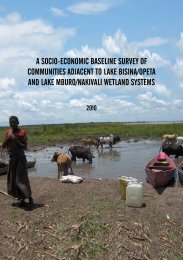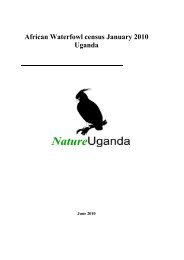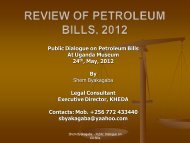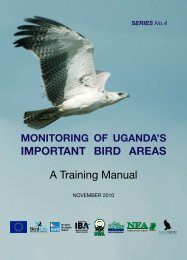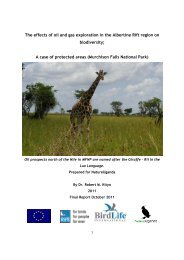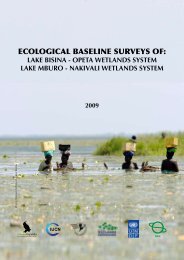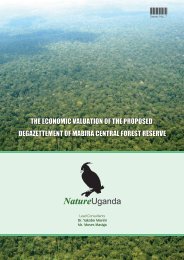Status and Trends 2009 - Nature Uganda
Status and Trends 2009 - Nature Uganda
Status and Trends 2009 - Nature Uganda
Create successful ePaper yourself
Turn your PDF publications into a flip-book with our unique Google optimized e-Paper software.
Chapter one<br />
Introduction<br />
The concept of using Important Bird Areas to protect<br />
biodiversity is not new in Ug<strong>and</strong>a. It is over 15 years since<br />
the programme was initiated in the country. The programme<br />
identified 30 IBAs (now 33) <strong>and</strong> produced a directory,<br />
advocated for better policies, initiated conservation <strong>and</strong><br />
livelihood improvement programmes <strong>and</strong> raised the profile of<br />
ten wetl<strong>and</strong>s that are IBAs into Ramsar sites. These are just<br />
a few of the many things that came with the IBA concept <strong>and</strong><br />
biodiversity conservation. To realize these, <strong>Nature</strong>Ug<strong>and</strong>a<br />
involved a number of stakeholders that included government<br />
departments [(Ug<strong>and</strong>a Wildlife Authority (UWA), National<br />
Forest Authority (NFA), <strong>and</strong> Wetl<strong>and</strong>s Management<br />
Department (WMD) etc], various Non Governmental<br />
Organizations (NGOs), research institutions <strong>and</strong> local<br />
communities. In short, the IBA concept is not strange in the<br />
conservation world <strong>and</strong> it is widely accepted <strong>and</strong> supported.<br />
In Africa, there are over 1230 IBAs <strong>and</strong> over 10,000 world<br />
wide.<br />
What are Important Bird Areas (IBAs)<br />
IBAs are sites of global conservation importance identified<br />
using birds to locate key sites for conservation across the<br />
globe. They are practical tools for conservation. IBAs are<br />
identified using st<strong>and</strong>ard internationally agreed criteria, which<br />
are; objective, quantitative <strong>and</strong> scientifically defensible. They<br />
must however, be large enough to support self-sustaining<br />
populations of those species for which they are important.<br />
Why is monitoring <strong>and</strong> status <strong>and</strong> trends report IBA<br />
important<br />
Locally <strong>and</strong> nationally, this is done to detect <strong>and</strong> act on threats<br />
in good time. Assess the effectiveness of conservation efforts<br />
<strong>and</strong> provide information on biodiversity trends. The monitoring<br />
programmes have schedules but annual IBA monitoring<br />
is the target. To ensure that biodiversity <strong>and</strong> its habitats<br />
are conserved in a good way, we need to monitor these<br />
habitats <strong>and</strong> provide information that will guide management<br />
decisions.<br />
Levels of monitoring<br />
The basic level of monitoring takes the form <strong>and</strong> advantage of<br />
low-level <strong>and</strong> low-cost opportunities. This seeks to involve local<br />
communities in data collection. This simple nature allows<br />
sharing of responsibilities <strong>and</strong> encouraging data collection<br />
skills development.<br />
The detailed level of monitoring aims to deliver deeper analyses.<br />
Considering the robust nature, this may target only specific<br />
sites with serious threats <strong>and</strong> it is very much dependant on<br />
available funding. A range of variables may be monitored <strong>and</strong><br />
these need not be the same. Based on this analysis, the twotier<br />
IBA monitoring framework was developed.<br />
The SPR model<br />
Aims of the IBA Programme<br />
The function of the IBA programme is to identify <strong>and</strong> protect a<br />
network of sites, at a scale large enough to ensure long term<br />
survival of naturally occurring bird populations. It is meant to<br />
cover the range of those bird species for which a site-based<br />
approach is appropriate. The IBA process has been used to<br />
build institutional capacity <strong>and</strong> set an effective conservation<br />
agenda without much technical research exercise.<br />
Pressure<br />
Threats<br />
State<br />
Condition<br />
Response<br />
Conservation effort<br />
Introduction to IBA monitoring framework<br />
The framework introduces on top of identifying IBAs, the<br />
aspects of monitoring <strong>and</strong> protecting a network of these<br />
critical sites for the world’s birds. Monitoring here is used<br />
to mean the continual collection of information overtime, in<br />
order to detect changes in one or more variables <strong>and</strong> this is<br />
sequentially done in five questions for it to be successful.<br />
• Why monitor<br />
• What should we monitor<br />
• How should we monitor<br />
• Who should monitor<br />
• What happens next<br />
Fig. 1 Diagrammatic relationship in SPR monitoring model<br />
Mode of operation<br />
A simple global monitoring framework for IBAs has been<br />
designed. An IBA monitoring form for Ug<strong>and</strong>a has been<br />
adopted from this framework. This is a simple <strong>and</strong> easy to<br />
use form designed with an annex of instructions or guidelines.<br />
The variables have been often referred to as State, Pressure<br />
<strong>and</strong> Response making it simply be called “the SPR model”.<br />
The three variables (SPR) complement each other <strong>and</strong> all<br />
contribute to the resultant trend analyses.<br />
All these questions are important, but the first <strong>and</strong> last<br />
generally receive far less attention than the others. Overall,<br />
the reason for monitoring IBAs is clear. We need to<br />
underst<strong>and</strong> what is happening to them in order to adapt our<br />
interventions accordingly. To be effective, all information from<br />
the monitoring schemes should be integrated. There are<br />
many ways to categorize indicators, but the SPR framework<br />
has been widely adopted.<br />
<br />
State or status means the condition of the IBA. The status<br />
of the IBAs can be assessed in two ways. The first way is by<br />
obtaining the population of the trigger species <strong>and</strong> relating to<br />
the habitat. And the second way is by using habitat as proxy<br />
as long as one has sound basis for using habitat. The most<br />
important to know is the relationship between habitat area<br />
<strong>and</strong> quality <strong>and</strong> bird numbers.



